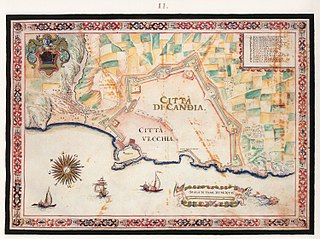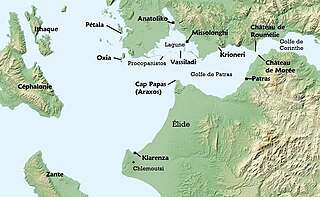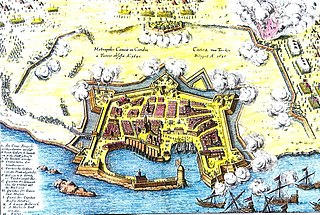This battle took place on 26 May 1646 at the mouth of the Dardanelles Strait, during the Cretan War. The Ottoman fleet under the Kapudan Pasha, Kara Musa Pasha, tried to defeat the Venetian fleet, under Tommaso Morosini. The Venetians were blockading the Dardanelles, trying thus to prevent reinforcements and supplies to be brought to Crete, a Venetian possessions which the Ottomans had invaded the previous year, and to disrupt the flow of supplies to the Ottoman capital, Constantinople.
This battle took place on 21 June 1655 inside the mouth of the Dardanelles Strait. It was a clear victory for Venice over the Ottoman Empire during the Cretan War.

The Third Battle of the Dardanelles in the Fifth Ottoman-Venetian War took place on 26 and 27 June 1656 inside the Dardanelles Strait. The battle was a clear victory for Venice and the Knights Hospitaller over the Ottoman Empire, although their commander, Lorenzo Marcello, was killed on the first day.
This battle, which took place on 16 May 1654, was the first of a series of tough battles just inside the mouth of the Dardanelles Strait, as Venice and sometimes the other Christian forces attempted to hold the Turks back from their invasion of Crete by attacking them early.
This battle was fought on 10 July 1651, with some minor fighting on 8 July, between the islands of Paros and Naxos in the Aegean Sea, between the Venetian and Ottoman fleets. It was a Venetian victory, but failed to achieve anything decisive.

The Morean war, also known as the Sixth Ottoman–Venetian War, was fought between 1684–1699 as part of the wider conflict known as the "Great Turkish War", between the Republic of Venice and the Ottoman Empire. Military operations ranged from Dalmatia to the Aegean Sea, but the war's major campaign was the Venetian conquest of the Morea (Peloponnese) peninsula in southern Greece. On the Venetian side, the war was fought to avenge the loss of Crete in the Cretan War (1645–1669). It happened while the Ottomans were entangled in their northern struggle against the Habsburgs – beginning with the failed Ottoman attempt to conquer Vienna and ending with the Habsburgs gaining Buda and the whole of Hungary, leaving the Ottoman Empire unable to concentrate its forces against the Venetians. As such, the Morean War was the only Ottoman–Venetian conflict from which Venice emerged victorious, gaining significant territory. Venice's expansionist revival would be short-lived, as its gains would be reversed by the Ottomans in 1718.

The Cretan War, also known as the War of Candia or the fifth Ottoman–Venetian war, was a conflict between the Republic of Venice and her allies against the Ottoman Empire and the Barbary States, because it was largely fought over the island of Crete, Venice's largest and richest overseas possession. The war lasted from 1645 to 1669 and was fought in Crete, especially in the city of Candia, and in numerous naval engagements and raids around the Aegean Sea, with Dalmatia providing a secondary theater of operations.

The Ottoman–Venetian peace treaty of 1419 was signed between the Ottoman Empire and Republic of Venice, ending a short conflict between the two powers, confirming Venetian possessions in the Aegean Sea and the Balkans, and stipulating the rules of maritime trade between them.

The siege of Corfu took place on 8 July – 21 August 1716, when the Ottoman Empire besieged the city of Corfu, on the namesake island, then held by the Republic of Venice. The siege was part of the Seventh Ottoman–Venetian War, and, coming in the aftermath of the lightning conquest of the Morea by the Ottoman forces in the previous year, was a major success for Venice, representing its last major military success and allowing it to preserve its rule over the Ionian Islands.

The siege of Santa Maura took place on 21 July – 6 August 1684 between the forces of the Republic of Venice and the Ottoman Empire, and was the opening battle of the Sixth Ottoman–Venetian War. From his base at Corfu the Venetian commander-in-chief, Francesco Morosini, led a fleet of 38 galleys, 8 galleasses and several auxiliary vessels to besiege the Fortress of Santa Maura on the island of Lefkada, that was under Ottoman rule. The besieging forces were swelled by Greek levies and volunteers from the Ionian Islands. The siege lasted until 6 August, when the commander Bekir Agha, bowing to pressure from the 500 Albanians and 200 Greeks in the fortress garrison, surrendered to the Venetians.

The siege of Coron was the capture of the Ottoman fortress of Coron (Koroni) in the southwestern Morea (Peloponnese) by the Republic of Venice in 1685. It signalled the start of the Venetian conquest of the Morea during the Great Turkish War. Along with neighbouring Modon (Methoni), Coron had been strategically important Venetian bases until captured by the Ottomans in 1500. When Venice declared war on the Ottomans in 1684, the Venetian commander-in-chief, Francesco Morosini, quickly set his sights on a conquest of the Morea as a revenge and recompense for the recent loss of Crete. In this he hoped to have the assistance of the Maniots, a semi-autonomous and restive population that resisted Ottoman authority. However, the Ottomans pre-empted the Venetians by invading the Mani Peninsula and garrisoning its fortresses. Rather than land at Mani, therefore, Morosini chose to target Coron, securing for himself a base of operations and encouraging the Maniots to rise up by a display of military might. The Venetian forces began the siege on 25 June by digging trenches to isolate the citadel of Coron from the landward side, and began a bombardment from both land and sea. An Ottoman relief army, under the governor of the Morea, Halil Pasha, soon arrived, and a month of bloody fighting began between the Venetians and the Ottoman relief army, all the while attempts to breach the citadel walls continued. The decisive combat took place on 7 August, when the Venetian lines were broken through; a counterattack at dawn however threw the Ottomans back and dispersed their army. Free to focus on the siege, the Venetians launched a major assault on 11 August, forcing the fortress to surrender. During the negotiations, the accidental explosion of a cannon led to the massacre of the garrison due to fears of treachery. With Coron secured, the Venetians moved towards Mani, which rose in revolt. A major victory over another Ottoman army followed at the Battle of Kalamata, and the conquest of Messenia was completed in the next year with the capture of New Navarino fortress and Modon.

The Battle of Gallipoli occurred on 29 May 1416 between the fleets of the Republic of Venice and the Ottoman Empire off the port city of Gallipoli, the main Ottoman naval base. The battle was the main episode of a brief conflict between the two powers, resulting from Ottoman attacks against possessions and shipping of the Venetians and their allies in the Aegean Sea in 1414–1415. The Venetian fleet, under Pietro Loredan, was charged with transporting a Venetian embassy to the Ottoman sultan, but was authorized to attack if the Ottomans refused to negotiate. The subsequent events are known chiefly from a detailed letter written by Loredan after the battle.

Vettore Cappello was a merchant, statesman and military commander of the Republic of Venice. After an early career as a merchant that gained him substantial wealth, he began his political career in 1439. His ascent to higher offices was rapid. He is chiefly remembered for his advocacy of a decisive policy against the Ottoman Empire, and his command of Venetian forces as Captain General of the Sea during the lead-up to and the first stages of the First Ottoman–Venetian War.

The siege of Navarino was a military engagement between the Holy League fleet led by John of Austria who besieged the Ottoman garrison in Navarino. The siege ended in failure and the withdrawal of the Christian armada.

The Battle of Kalamata took place on 14 September 1685 between the expeditionary army of the Republic of Venice in the Morea, led by Hannibal von Degenfeld, and the forces of the Ottoman Empire, led by the Kapudan Pasha. The battle ended in a Venetian victory, which allowed the Venetians to complete the conquest of the Mani Peninsula, solidifying their foothold in the southern Morea.

The Battle of Patras was a military engagement between the Venetian army and the Ottomans. The Ottomans emerged victorious, defeating two Venetian armies in Patras.

The siege of Chania happened during the initial stages of Cretan War (1645–1669). The Ottomans besieged the Venetian-held city of Chania, and after 56 days of siege, the Ottomans captured the city.

The siege of Lemnos happened during the Cretan War when the Ottomans launched a campaign to reconquer the island of Lemnos from the Venetians. The Ottomans captured the island in the end.

The siege of Rethymno happened during the Cretan War when the Ottomans launched a campaign to conquer the city of Rethymno in Crete from the Venetians. The Ottomans captured the city in the end.
The Battle of Chania took place on 14 August 1646, when the fleet of the Republic of Venice and her allies, under Giovanni Cappello, tried to destroy the Ottoman ships at anchor in the port of Chania, on Crete. The attack was a failure, as the Venetians could not penetrate the harbour defences.















